Hardship & Grace
By Terri Mason
The story of the Cottonwood Livestock outfit is one of hardship and grace. “Our place is on the north bank of the South Saskatchewan River, about 25 miles west of Medicine Hat,” said Gord Forbes. “We’re in a dry area, so we’ve got rattlesnakes and scorpions — all those things that only live in semi-arid areas.” ~ Gord and Patti Forbes
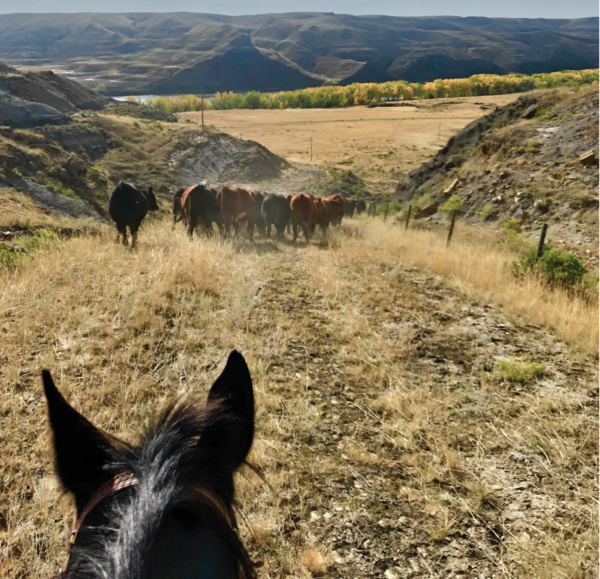
Their ranch is deceptively simple, governed by sense and necessity, overcoming hardships that broke many others.
“We bought the place in ’98,” said Patti. “First BSE hit next came Hoof and Mouth, then we had the drought, and we pumped water. We sold all our cattle when we couldn’t feed our way out of the drought in 2001 and eventually rebuilt our herd.”
And the Forbes family is still here.
“We are a cow/calf-yearling operation,” said Gord. “In dry years like this, we’re mostly cow/calf. That’s our buffer; you can always get rid of yearlings and get your money back. It’s a little bit harder to dispose of cows and calves at different times of the year. This year, we dumped all the yearlings early except for the replacement heifers.”
The couple also have the benefit of their two sons, Casey and Kyle, working alongside them.
They, too, live down on the river flat with their families. They also have a daughter, Hilary. A horsewoman, she founded Holsom Equine Rehabilitation and Conditioning, a thriving horse business west of the [Medicine Hat] airport.

An early aerial shot of the Cottonwood ranch yard; their branding pens are elsewhere
On the ranch, both sons have their expertise. “We’re fairly progressive, and we give credit to our sons,” said Gord. The young men enjoy researching their specialties; Casey oversees buying the feed, mineral packages, and ration planning and Kyle is the grass management guy. He also handles all access requests for the ranch.”
“They like to do the research; everything we do around here has to pass the stress test,” said Gord. “We have a meeting every morning in the shop and go over what we think we should be doing. When somebody brings up an idea, it’s got to show that it’s worthwhile and economical.”
The Cottonwood is a real throwback to the old ways. “We don’t have any hay land or cropland, so the cows feed themselves,” explained Gord. When the ranch must buy feed, the total cost is high, so the cattle mostly feed themselves.
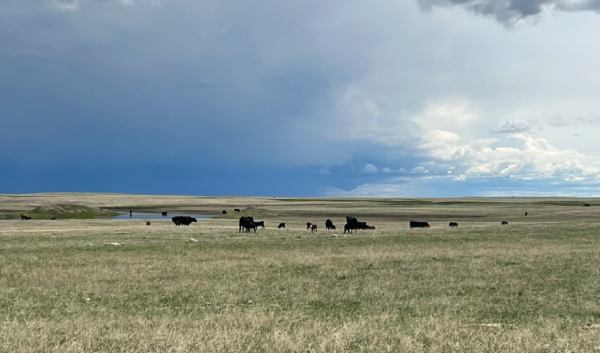
A long view of Cottonwood cattle on pasture; you can see off in the distance the rain is falling
Explains Gord, “We’ve got a big winter field, it’s about five miles long down along the river bottom, and about 300 cows spend the winter there. They use up the hillsides pretty badly if we have a tough winter. Because of the ice, they don’t want to go out and graze. We feed them during the tough days. On the good days when it warms up, they go up top and graze until the weather pushes them back down onto the river bottom. Then we start feeding again.”
Sheer economics have changed their feed, too. “For the last three years, we’ve had corn silage delivered from Bow Island.” About two-thirds of the price of hay, silage accounts for about 70 percent of the ration, plus 20 percent straw and 10 percent alfalfa hay to bring up the protein. The ranch has a chopper mill, and their corn supplier delivers.
Calving is streamlined by good stockmanship. Their heifers start calving in mid-April, their cows about a week and a half later.
The heifers are moved in close to the ranch buildings into a couple of 50-acre fields. They graze during the day, and they’re brought in and fed in the evening. “We’ve been doing that for 40 years, and we’ve got the data showing they calve mostly in the daytime,” said Gord.
He continued. “Those old guys always said, ‘The first thing a cow’s going to do is look after herself. She’s going to come up and eat, and after she’s done digesting some of that feed, she’ll worry about calving.’ It works for us, and we don’t check our heifers at night. We seldom end up pulling a calf; plus, we use low birth-weight Angus bulls.”
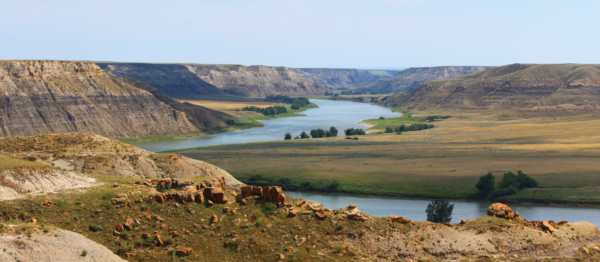
While scenic, the stark and forbidding strata of sedimentary rock is very fragile. The Forbes’ and other area ranchers protect this land.
“The other problem with calving heifers is when you’ve got two heifers wanting the same calf,” he added.
To countermand that, the heifers and their calves are moved into one of a dozen individual pens so they can ‘mother up.’ After a short while, the heifer and calf are let into a small field. As soon as they are bonded, they let the pairs range into their tame grass fields.
The Cottonwood boasts 75 percent native grass. “Most years, we don’t go onto our native pastures until July, but this year, we had to go a wee bit earlier because the tame grass didn’t grow,” said Gord. Drought isn’t new here; the ranch still has traces of the rock rows that once marked homesteads — all abandoned.
One headache Cottonwood shares with many other producers is the revolving door of government ministers. “With every new minister that gets in, we have to fight to protect the land,” says Gord.
“They want to open the grazing lease for hunters, recreationists, etc. It’s tougher for us to keep them out because we are along the river. The government want to let them come in and drive quads or motorbikes or whatever on the land, and they’d destroy it.” It’s not just the damage to the land that concerns the family, but the threat of fire is always on their minds.

Back, from left: Kyle and Allana, Carina and Casey, Jerrod and Hilary Blanchette; middle from left: Alexa, Tristan, Patti, Gordon, Tessa; Front from left: Korbin, (cowboy hat) Kaden, Quinn and Kate
Not only are they protecting the land itself, but many endangered species. “Most live close to the river, so you can’t have people just coming and going and abusing the land. So we’re protective. Our son, Kyle, is the chairman of the Alberta Leaseholders Association, so he’s even more protective about our ground.”
Cattle handling skills are paramount, and Cottonwood has two brandings a year.
“The first one is our family branding; we do about do about 60 to 100, mainly the grazing lease calves,” said Gord. “We get the wives inoculating and teach kids how to hold down a calf. This gives the younger generation a chance to learn without all the high stress of our larger branding.”
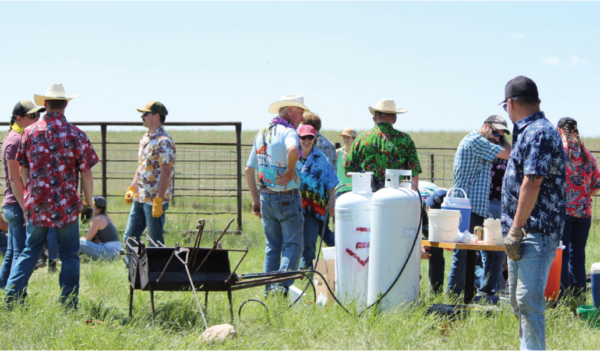
A fun Hawaiian Shirt Branding with their military friends; notice the double-sided branding pot and the grassy pen, which makes for a clean and dust-free day
For the big branding, they use an efficient crew made up of our tech crew for the main jobs and the military and friends for the wrestling.
Then there’s the military connection with the British officers based at Suffield.
In the late 1990s, the area was hit with another drought. They could pump water from the river but had to lay the pipe themselves — nine miles of pipe.
Said Patti, “Gord got the pump and pipe from Alberta Ag, and when we were discussing how we were going to do this, our officer friends in the British military said, “We will come and help you.”
Gord said, “I need to have a two-week commitment from you,” and those guys were here every day. At any one time, we had eight miles of pipe laid out, and those men came every day and moved it. So as a thank you, we started doing the military branding, and they came every year.”
The Ralston Rodeo, a staple in the area, had been suspended for a couple of years due to Foot and Mouth and a lack of help to start it up again.
“Patti and I volunteered to help the military get it up and going again. With a lot of help from family and great friends, we were able to assist them in the rodeo portion for over 10 years, said Gord. “I have been a member of the Officer’s Mess, and we ended up with many good friends in the military. We had more of a connection with the British simply because they all lived in the village, and our kids went to school there.”
The Cottonwood also hosted many British military parties. “We’ve had generals here, the head commander of the British military, and we’ve hosted battle group parties, including one for the Royal Scots Dragoon Guards,” said Patti.
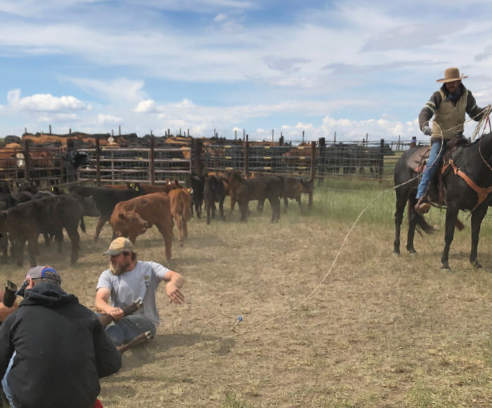
The Forbes’ brand with roping and wrestling. The wrestlers are mostly their military and family friends.
“They brought their pipe and drum band who played the music for the movies Last of the Mohicans and Braveheart. The band marched up from the river playing that music, and as the sun set, the pipers went up on the hill and played “Amazing Grace,” she paused. “It was unreal.”
The military has been very good to the Forbes family and vice versa.
“We had a French officer who wore white chino pants at the branding, and they got so filthy I offered to wash them. ‘No,’ he told me. ‘I’m going to frame these!’” she laughed.
In the long run, the Forbes family probably did as much for Canadian-British relations as any diplomat, plus also solidified an honest appreciation by the military for the Western lifestyle.
The sprawling Cottonwood outfit is in tough, rugged country, but it’s home — home to those with grit.















